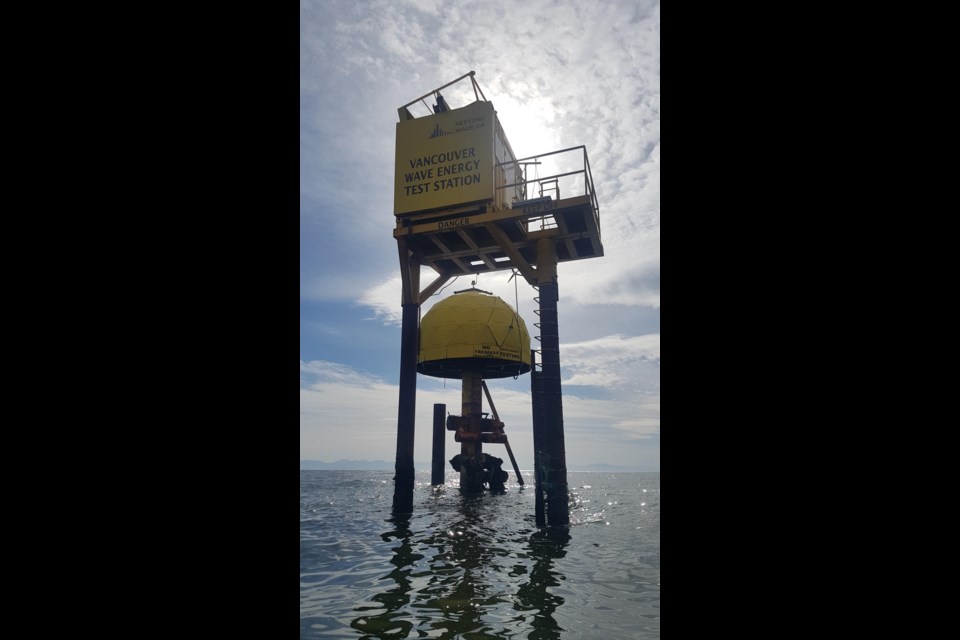Inspiration and passion for a life-changing project can strike at a moment’s notice -- for Charles Haynes, that moment was 3 a.m. at his cabin on Keats Island over a decade ago.
Just hours before, Haynes had been discussing renewable energies with his wife. To Haynes, solar power would be thwarted by Vancouver’s frequently cloudy skies and as B.C. isn’t known for being all that gusty wind power was also a no-go. The two went to bed but hours later Haynes woke and looked out to the waves crashing onto beaches in Howe Sound, wondering if he could harness their energy. After making dozens of inquiries into already existing wave-based energy companies looking to get his hands on a wave engine of his own and getting nowhere, Haynes set off to solve the problem on his own.
"I thought 'well I'll just make one, can't be that hard,'" Haynes joked in a recent interview with Vancouver Is Awesome.
The 'doughnut on a stick' design
That was 11 years ago. Since then Haynes founded Neptune Equipment Corp. with money he acquired through flipping Vancouver apartment buildings over the last 25 years. It was that capital that allowed Haynes to design and fabricate several prototype wave engines and erect a testing rig in 2018 just 800 meters off Wreck Beach.
Previous designs included a large metal arm that would bob up and down in the waves to generate electricity but the arm broke in 2019 sending Haynes back to the drawing board. In 2020 Haynes had a new design and added the Vancouver wave energy test station next to the new and improved engine so others could verify the amount of electrical current made by the engine.
In the barest description possible, Haynes' newest wave engine looks like a “doughnut on a stick.” The "doughnut" is a float that’s three meters in diameter, two meters thick and weighs 10 metric tonnes. The "stick" is a piling embedded into the seafloor which the float moves up and down on with the waves.
NeptuneWave Oct 24 2019 Float Movement from Charles Haynes on Vimeo.
Electricity is generated from this movement using a translator design patented by Haynes and is then sent to resistors housed in the dome above the water.
While B.C.’s coastline doesn’t have the largest waves or tidal movements compared to other parts of Canada or the rest of the world, smaller waves suit Haynes just fine. With his float design, he says the more common faster waves are able to make the engine’s float travel a greater distance than it would with larger slower waves.
'Continuous power with variability'
Haynes says the engine is capable of producing anywhere from 1-20 kilowatts of power but the most he has ever seen it produce is 12 kW from large waves made during a storm. Most of the year the waves are small, generating between 1 and 4 kW.
"The key thing about waves, which is different from wind and solar, is that waves are continuous power with variability. Whereas solar and wind are intermittent power with variability," Haynes explained. "So with wave energy, there's constant power, there's always some energy there."
An alumnus of the University of British Columbia’s school of architecture, Haynes holds a degree in creative problem solving and has worked as a project manager. Haynes says it is this experience combined with the financial freedom of creating his own company that has allowed him to succeed and fail without dependence on grant money from governments or other organizations.
"At nighttime, I draw up the plans using a 3D modelling program from my architecture world and then I go and build a little model and then we go and build another one," Haynes said.
Big plans for the future
In a presentation Haynes gave last year to the UBC Physics & Astronomy department he explained how several of his wave engines could be attached to already installed wind turbines set in the ocean. For now, though, Haynes is working on improving his wave engine with a newly modified version of the float which he expects will be installed this fall.
As for what the future of wave energy as a whole will bring, according to Haynes the skies the limit.
"I think wave energy will be larger than solar and wind combined. Without a doubt. I can't understand why more people haven't got into wave energy," he said.
To find out more about Haynes’ work you can check out Neptune Equipment Corp.’s website.




